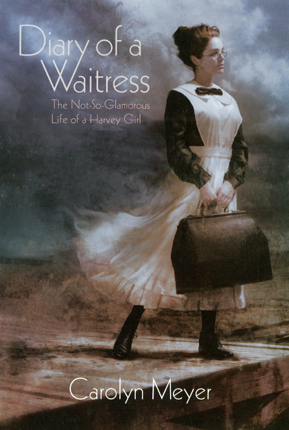Full Text Reviews: School Library Journal - 02/01/2015 Gr 7–10—It is 1926, and Kitty Evans is looking forward to finishing high school and going to college to become a journalist. Unfortunately, her father informs her that there isn't enough money to educate both her and her brother and that she will have to get a job. With her dreams shattered, Kitty answers a newspaper ad for a Harvey Girl. After six weeks of training, she'll be transferred to one of many Harvey restaurants located along train lines in the western United States. Little does Kitty know that the rules and expectations of a Harvey Girl are very strict. She meets some new friends including Cordelia, a debutante from Philadelphia who wears short flapper dresses and bright red lipstick, and Emmy, another girl who hopes to make money to send back to her family. Cordelia encourages the girls to try new things, Emmy reminds them of the rules, and Kitty documents it all. The narrative is told through a series of diary entries in which Kitty notes her challenges—from the job interview and telling her parents about life-changing decision to making friends and meeting all kinds of characters. Kitty records interactions with everyone from railroaders to politicians to hobos. She also has many admirers and is asked to "go for walks" and to "save a dance" at local gatherings. Meyer includes primary-source photographs throughout to illustrate the Harvey buildings and train stations, as well as local people. Kitty encounters many travelers from around the world, hearing German, Spanish, and some local slang as she travels from Kansas to New Mexico. Readers will feel connected to Kitty and her group of girlfriends and hope for their success. VERDICT A fast and interesting read about a part of history of which many readers may be unaware.—Jessica Lorentz Smith, Bend Senior High School, OR - Copyright 2015 Publishers Weekly, Library Journal and/or School Library Journal used with permission. Bulletin for the Center... - 05/01/2015 Kitty Evans can’t understand the casualness with which her family delivers the shattering news: a downturn in her father’s business means she won’t be attending college, and she should plan to begin work at the local shoe store right away. It’s 1926, and Kitty has bigger plans for a journalism career, and if college can’t be her route to independence, then surely signing on as a Harvey Girl waitress will be her ticket to new adventures and a broader worldview. Landing the job isn’t difficult, and her parents swallow pride and skepticism to reluctantly support her decision. The reality of the job itself, though, is quite another matter. First there’s a month of unpaid training at one of the smaller Harvey depot restaurants, at which the new hires stay in a tightly supervised hotel wing and put in long hours learning the meticulous detail of “the Harvey Way” of hospitality, serving train passengers on strict schedules, as well as railroad workers and townsfolk. With hard work and luck, the probationary period concludes with a brief visit home and then reassignment further along the Santa Fe Railway line. The Harvey waitress schedule doesn’t leave much time for launching a journalism career, but with some advice from an editor patron, Kitty hones her observational skills and sells her first stories based on local events in her depot assignments. Kitty and several of her waitress friends could easily have propelled any number of subplots, but Meyer keeps the blossoming romances tepid, the women’s rights theme underexplored, and hints of racial discrimination and social censure of the “loose” Harvey Girls left largely unexamined. Nonetheless, the Harvey Girl experience, which offered many young women a career path other than teaching, nursing, or motherhood, will certainly be of interest to historical fiction fans. EB - Copyright 2015 The Board of Trustees of the University of Illinois. Loading...
|



